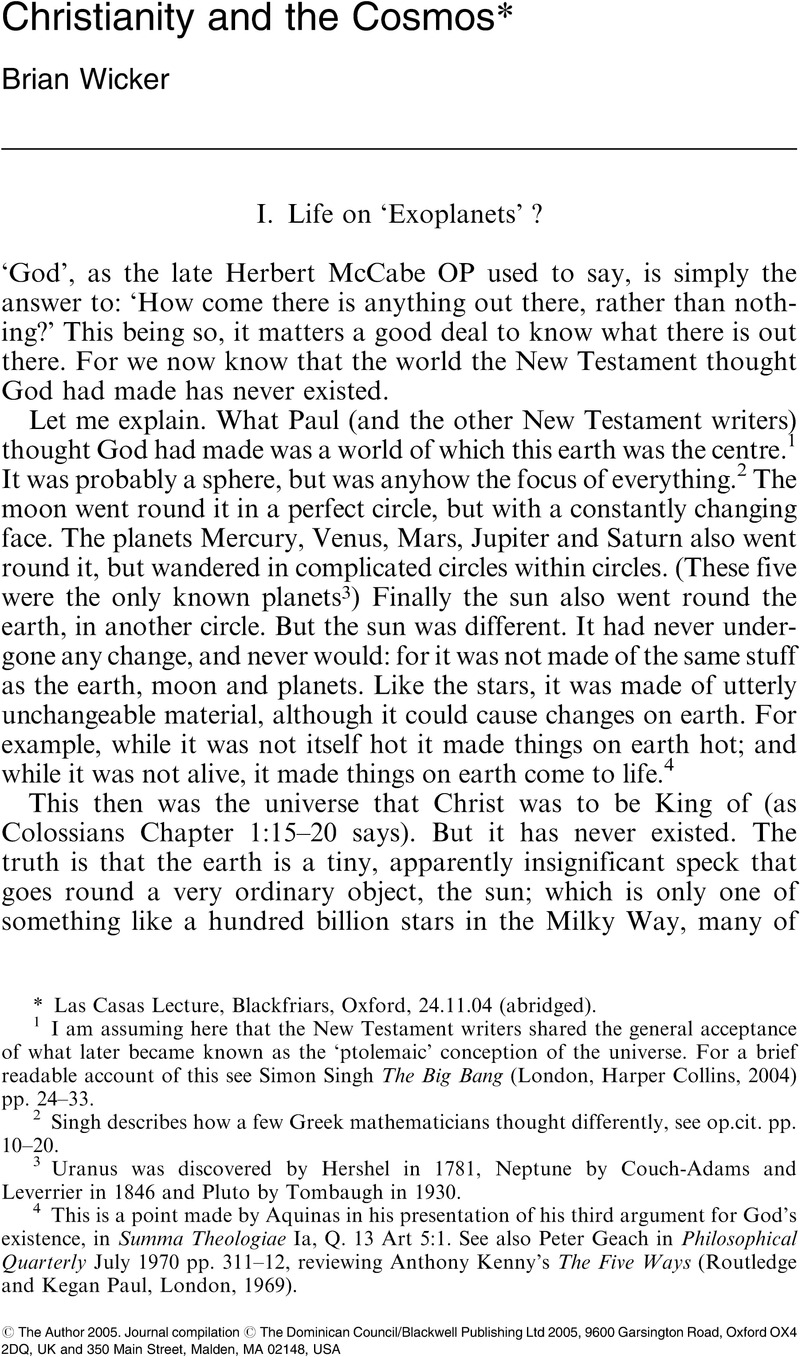No CrossRef data available.
Article contents
Christianity and the Cosmos
Published online by Cambridge University Press: 01 January 2024
Abstract

- Type
- Original Articles
- Information
- Copyright
- Copyright © The Author 2005. Journal compilation © The Dominican Council/Blackwell Publishing Ltd 2005, 9600 Garsington Road, Oxford OX4 2DQ, UK and 350 Main Street, Malden, MA 02148, USA
Footnotes
Las Casas Lecture, Blackfriars, Oxford, 24.11.04 (abridged).
References
1 I am assuming here that the New Testament writers shared the general acceptance of what later became known as the ‘ptolemaic’ conception of the universe. For a brief readable account of this see Singh, Simon The Big Bang(London, Harper Collins, 2004) pp. 24–33Google Scholar.
2 Singh describes how a few Greek mathematicians thought differently, see op.cit. pp. 10–20.
3 Uranus was discovered by Hershel in 1781, Neptune by Couch‐Adams and Leverrier in 1846 and Pluto by Tombaugh in 1930.
4 This is a point made by Aquinas in his presentation of his third argument for God's existence, in Summa Theologiae Ia, Q. 13 Art 5:1. See also Peter Geach in Philosophical Quarterly July 1970 pp. 311–12, reviewing Kenny's, Anthony The Five Ways(Routledge and Kegan Paul, London, 1969)Google Scholar.
5 Singh, op. cit. p. 284.
6 Mayor, Michel and Frei, Pierre‐Yves, New Worlds in the Cosmos: the Discovery of Exoplanets, (Cambridge University Press, 2003) p. 192CrossRefGoogle Scholar.
7 Royal Astronomical Society press release, 1st. April 2004. By 19th February 2005 the total had risen to 145 (http://www.universetoday.com 19.2.05).
9 Rees, Martin, Our Final Century(London, Arrow Books, 2004)Google Scholar says so on p. 159. But on the next page he gives a number more in line with what was said immediately above.
10 Ingredients are There to Make Rocky Planets, from Universe Today #962: Space News from Around the Internet(25.11.04 on http://www.universetoday.com).
11 For the numbers see Singh, Simon, Big Bang(London and New York, Fourth Estate, 2004) p. 3Google Scholar.
12 Mayor and Frei, pp. 209–10.
13 Jerusalem Bible (London, Darton, Longman and Todd, 1966), Colossians, p. 345, note e.
14 Paradise Lost, Book X, ll. 668ff.
15 Mayor and Frei, p. 22.
16 Wicker, Brian, The Story‐Shaped World(London, Athlone Press, 1975) Chap. 3 passimGoogle Scholar.
17 ‘For angels to change place takes time: continuous time for continuous movements, discontinuous for discontinuous movements. But not the time that measures the rotation of the heavens and all the bodily changes that result from it. In discontinuous movement, the angel is now here now there with no time‐interval between’. Aquinas, Summa Theologiae Ia Q. 53 Art 3 in the concise translation edited by Timothy McDermott (London, Eyre and Spottiswoode, 1989) p. 96.
18 Recent research suggests that even if intelligent beings from outside the solar system were trying to communicate with us by radio, their signals would probably be indistinguishable from the radiation ordinarily given out by stars. See Universe Today #965: Would we mistake signals from ET?.
19 A very young galaxy, 1 Zwicky 18, only 500 millions years old (the Milky Way is about 12 billion years old) has recently been discovered. It will provide information about the way stars formed, and are still forming, out of clouds of hydrogen and helium. (Universe Today #964, 01.12.04). This issue of The Universe Today also reports the discovery of a ‘cool accretion disc’ round Vega (one of the brightest stars in the sky), suggesting the beginning of a solar system round that star.
20 McCabe, Herbert, God Matters(London, Geoffrey Chapman, 1987) p. 69.Google Scholar
21 See Ruston, Roger, Human Rights and the Image of God(SCM Press, London, 2004) passim.Google Scholar


